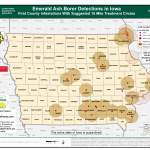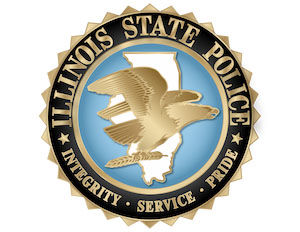Frequently Asked Questions/Answers on Emerald Ash Borer (EAB) -click ‘read more’ for a list of FAQ & a map of the confirmed infestation.
1. What is the emerald ash borer? It is a very small, shiny green beetle (½ inch long x ⅛ inch
wide; about the size of Mr. Lincoln’s image on a penny).
2. What does EAB eat? Hosts are species (and cultivars) of ash in the genus Fraxinus. Hosts include green ash (e.g., ‘Marshall Seedless’, ‘Patmore’, and ‘Summit’), white ash (e.g., Autumn Purple®) black ash, blue ash, and pumpkin ash. Manchurian and Chinese ash trees are primary hosts in its homeland [Eurasia]. A new host record of white fringetree (Chionanthus virginicus) was discovered in Ohio; this is not a common plant in Iowa. Mountain ashes (Sorbus species) are NOT hosts.
3. Where is EAB from? This beetle is native to Asia and is found in China and Korea. It also has been reported in Japan, Mongolia, the Russian Far East, and Taiwan. EAB arrived in the United States sometime before 2002 in wood packing materials. It has been recorded feeding on F. chinensis and F. mandshurica as a native borer.
4. How did it get to Iowa? Most EAB infestations in the United States have been started by people unknowingly moving infested firewood, nursery plants, or sawmill logs. The adult beetle also can fly short distances (2 to 5 miles).
5. Should I be concerned about EAB? Yes. It kills ash trees, usually in 2-4 years. In the Midwest, millions of ash trees have been killed by EAB since 2002. There are about 3.1 million urban ash trees and an estimated 52 million ash trees in forests in the state of Iowa. Statewide, Iowa averages 16-17% ash on city property, though the ash component in tree inventories can reach 87%.
6. How do I know if I have an ash tree in my yard? Two sources to check on tree identification are: https://store.extension.iastate.edu/ItemDetail.aspx?ProductID=1482 and http://www.extension.iastate.edu/forestry/iowa_trees/tree_id.html
7. How do I know if my ash tree is infested? Look for the following symptoms: https://store.extension.iastate.edu/Product/EAB-or-Native-Borer and https://store.extension.iastate.edu/Product/Common-Problems-of-Ash-Trees
a. Thinning or dying branches in the top of the tree
b. Water sprouts (suckers) halfway up the trunk
c. Feeding notches on edge of leaflets
d. Woodpecker feeding sites/many bark flakes on lawn
e. S-shaped feeding galleries under dead bark
f. D-shaped exit holes (1/8 inch diameter)
8. For counties not yet known to be infested with EAB, who can help me determine if my tree is infested? Contact one of the following if you suspect EAB in your tree:
a. State Entomologist Office, IDALS: 515-725-1465
b. Iowa DNR Forestry: 515-725-8453
c. ISU Extension and Outreach: 515-294-1101
9. Who should be thinking about treating ash trees? If you are a homeowner within 15 miles of
a known infested area, you can consider treatment of a healthy ash tree during the growing season (see #10 below). If you are not in a known infested area, treatment may be premature.
10. Ash Borer Management Options www.extension.iastate.edu/Publications/PM2084.pdf
a. Ash trees can be protected with insecticide applied by a commercial pesticide applicator or the homeowner. Trees must be healthy, vigorously growing, and valuable to your landscape.
b. Most of the treatments must be done each year for the life of the tree. Two active ingredients will last for two years in a light EAB infestation: emamectin benzoate and azadirachtin. In heavy EAB infestations, only emamectin benzoate is effective for two years; azadirachtin must be injected every year.
c. Keep in mind that treatment may not be effective for a given tree due to past injuries, age of the tree, soil moisture, soil compaction, and other site and environmental factors.
d. Preventive treatments are most effective. Infested trees with less than 30% dieback of the crown might be saved for a few years, but the tree’s crown will be misshaped as a result of removing the dead branches.
e. Ash trees within 15 miles of a confirmed EAB site are at risk of EAB attack. Preventive treatments are suggested within this risk zone, but may be premature outside this area. Continued monitoring of ash trees outside the risk zone for EAB symptoms is suggested.
f. Systemic insecticides require time and active tree growth for distribution in the ash tree.
Most products must be applied in early spring to be effective. Products containing emamectin benzoate can be trunk-injected throughout the growing season (until September 1) by a certified commercial pesticide applicator.
g. Soil drench homeowner treatments are effective for ash trees up to 60 inches in circumference (20 inches diameter), while granular treatments are recommended for trees up to 36 inches in circumference (12 inches diameter). Homeowners can make only one application per year. Trees larger than 60 inches in circumference (20 inch diameter) will need to be treated by a certified commercial pesticide applicator.
h. There are several treatment options available for ash trees when a commercial pesticide applicator makes the application. Always use a certified applicator with experience in
treating trees. To make a list of prospective certified applicators in your county/area, go to: http://www.extension.iastate.edu/psep/Publications/EAB/FindingACertifiedPesticideApplicator.pdf
i. There is a per acre use limitation for soil treatments and basal bark treatments; consult the product label when planning applications. There is no per acre use limitation for trunk injections.
j. ISU Extension and Outreach does NOT recommend canopy sprays because of limited
effectiveness, the need for specialized equipment, spray drift, and possible adverse effects to nontarget organisms.
11. If I am contacted by a pesticide applicator to treat ash trees for EAB in the fall or winter, what course should I take? The best time to make a preventive application for EAB is spring; some products can be used throughout the summer and early fall (before leaf color starts to change). IF you live within 15 miles of a confirmed EAB infested site, get an estimate for the treatment. It is best to get at least one additional estimate before any work is done. IF you live outside the risk zone, thank the applicator for showing interest and keep the company information on file.
12. Where has EAB been found in Iowa? EAB infestations have been confirmed in twenty Iowa counties. Johnson County is not considered infested at this time based on the finding of a single adult. Counties considered infested:
a. Allamakee –New Albin, Lansing, Black Hawk Point, Plough Slough (2010)
b. Appanoose – Moravia (2014)
c. Black Hawk–Waterloo (2014)
d. Boone – Boone (2014)
e. Bremer–Waverly (2014)
f. Cedar – Mechanicsville (2013)
g. Clinton – Clinton (2015)
h. Des Moines – Burlington (2013)
i. Henry – Mt. Pleasant (2014)
j. Jasper – Newton (2014)
k. Jefferson – Fairfield (2013)
l. Keokuk – Hedrick (2015)
m. Lucas – Private woodlot (2014)
n. Mahaska – Eddyville (2014)
o. Marion – Maryville (2014)
p. Monroe – Private property (2014)
q. Muscatine – Muscatine (2014)
r. Story – Story City (2014)
s. Union – Creston (2013)
t. Wapello – Eddyville (2014)
13. Now that EAB has come to Iowa, is there some plan to manage/contain this pest? Yes, a detailed plan has been developed by collaborative agencies. The EAB Response Plan and other current Iowa information about EAB are given at: http://www.extension.iastate.edu/psep/EmeraldAshBorer.html
14. What does an EAB quarantine mean? A quarantine by state and U.S. agriculture departments means that hardwood firewood, ash logs, and wood chips cannot be moved out of the area without a permit. Homeowners must not remove their ash tree or firewood from their tree to an area outside the quarantine. Tree removal companies must not haul logs or firewood outside the quarantine area unless inspected and treated as required by the regulations.
15. How many counties in Iowa have been quarantined? The entire state (99 counties) of Iowa has been quarantined for EAB.
16. What should a homeowner or tree care company do with ash trees cut down in or near the infested area? We request that you dispose or use the wood within your county.
17. What general recommendations are available to communities? The Iowa Department of Natural Resources – Forestry Bureau has worked with several communities to deal with EAB infestations. Contact Tivon Feeley (515-725-8453) for more information.
18. Where can I find current information about EAB on the Internet? Sites to gather current information about this exotic pest include:
a. National site: www.emeraldashborer.info
b. ISU Extension & Outreach site: http://www.extension.iastate.edu/psep/EmeraldAshBorer.html
c. IDALS site: www.IowaTreePests.com
d. IDNR site:
www.iowadnr.gov/Environment/Forestry/ForestHealth/EmeraldAshBorer.aspx
19. Who is a local contact? Call your county Iowa State University Extension & Outreach office for more information: Clinton County – 563-659-5125




















